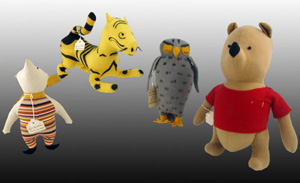
And imagine not always liking them all that much.
“They tended to take away my mother’s attention,” said Joyce Riemer of Stamford, laughing. “My father did more of the raising.”
But it wasn’t all bad, Riemer said, and as an adult, she now smiles when she talks about the creatures with whom she shared her Queens, N.Y., home as a little girl. And when she talks about her mother’s artistry, there is pride in her voice.
“We’d have Winnie the Poohs all over the house, in boxes and boxes,” she said. “A bunch would be all over the piano, drying.”
About 20 years before the Walt Disney Co. got hold of the licenses that allowed them to reanimate the inhabitants of Hundred Acre Wood, Riemer’s mother, Agnes Brush, was running a small but thriving cottage industry, making the plush animals based on the books from A.A. Milne.
Once a coterie of workers had sewn the dolls together, it would be Brush’s task to paint the details and make the finishing touches. They would then be sent off to bookstores and toy stores across the country.
Brush would often take to a porch outside their home to do her painting, a habit that was documented in a pictorial spread in Life magazine of Feb. 27, 1956. Brush was one of many featured in the magazine’s ode to Pooh. She even made it onto television, appearing with her daughter on broadcaster Nancy Craig’s television talk program Women of Tomorrow in the early 1950s.
Riemer, who said she was only 6 or 7 at the time, can recall watching the live cameras and the behind-the-scenes action.
“She did this work as long as I remember,” said Riemer, adding that it started before she was born in 1945.
Riemer, who was an only child, said she grew up in a creative house. Her father, Granville, was a draftsman. Her mother had started out as a milliner, but traded hats for plush toys when she was hired by Stephen Schlesinger, who had bought the rights to the A.A. Milne characters in the 1930s.
Eventually, Walt Disney would pay for those rights by the early 1960s, at about the same time Brush stopped making the dolls.
One can now find Agnes Brush toys being sold for several hundred to several thousand dollars on various websites. When Riemer was asked about how lucrative the business was, she said her mother “eked it out,” but that it was never a big moneymaker.
When Riemer’s mother died in 1982, she and her husband, Jay, went to the home to clear it of its belongings. While there, they not only found an inventory of dolls that had never made it to bookstore shelves, but also the records of Brush’s transactions, including the sales slips and notes.
“We’d find these nice handwritten notes from the businesses,” Jay Riemer said.
“The original toys were made with care and the people did appreciate that,” Joyce Riemer said. “There were a lot of letters to that effect.”
The couple, who have lived in Stamford since 1976, returned with several bags of toys, as well as supplies and original patterns.
Last year, the two decided to visit the Stamford Museum and Nature Center’s toy exhibit, Dolls, Toys and Teddy Bears, which has enjoyed a return engagement this year.
The two thought the museum might be interested in putting some of their collection on the display, even though they were not in mint condition – a case in point, a Winnie the Pooh doll, the only one that was on display at the Riemer home while their two children grew up, shows off the work of some hungry moths who left a few holes in his distinctive red shirt.
After the exhibit, they got in contact with Rosa Portell, the museum’s curator of collections and exhibitions, who urged them to come back this year.
“What I liked about Agnes Brush work was, first of all, it sprung out of a total home industry,” said Portell. “And, when the family brought their whole collection, I had several to choose from … No two were exactly alike. They all had incredible charm.”
The plush toys are just one of several stories in the exhibit, which ends Sunday, Jan. 9. There is a restored teddy bear whose owner made sure he would not be left behind when the family left Egypt in the early 1940s.
There is a group carefully painted lead figures, that were carefully researched and reconstructed by a Rowayton father and his children. And there is a dollhouse that has been passed down through the generations.
These well-worn and well-loved characters rest alongside some pristine antique dolls.
Portell said she enjoys the mix.
“I was happy to be able to include some toys that had interesting story lines,” Portell said.
Riemer knows well the story behind her mother’s work, and it is one she was happy to share with museum visitors. As to the enduring popularity of Winnie the Pooh and his pals, she thinks the universality of the characters have allowed the stories to linger through the generations.
“I remember I used to call my son Tigger, now that I think about it,” she said. “He was quite bouncy.”
___
Online:
http://www.stamfordmuseum.org/exhibit-spot.html
___
Information from: Stamford Advocate,
http://www.stamfordadvocate.com/
Copyright 2010 Associated Press. All rights reserved. This material may not be published, broadcast, rewritten, or redistributed.
AP-ES-12-25-10 0003EST


